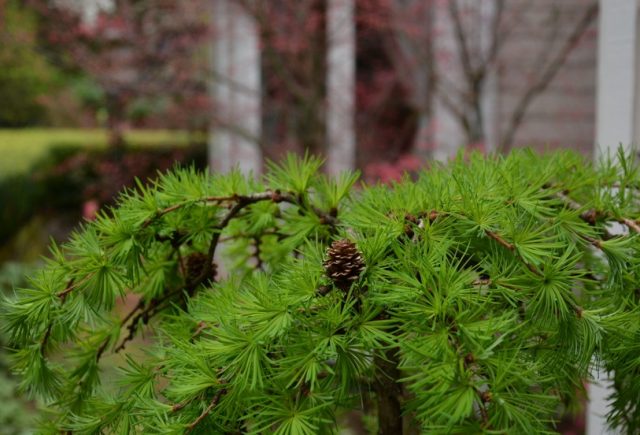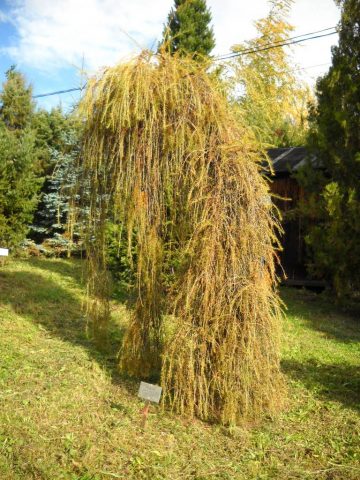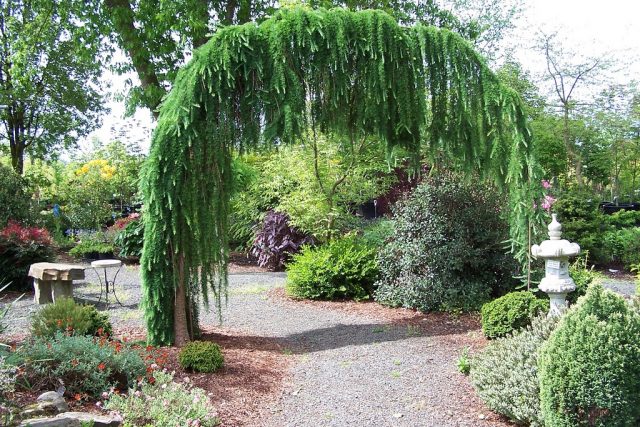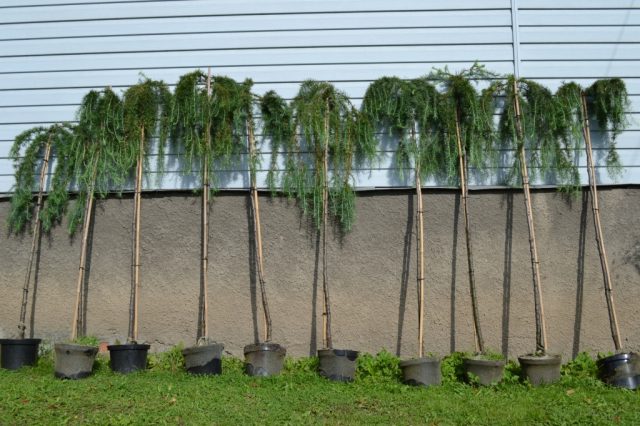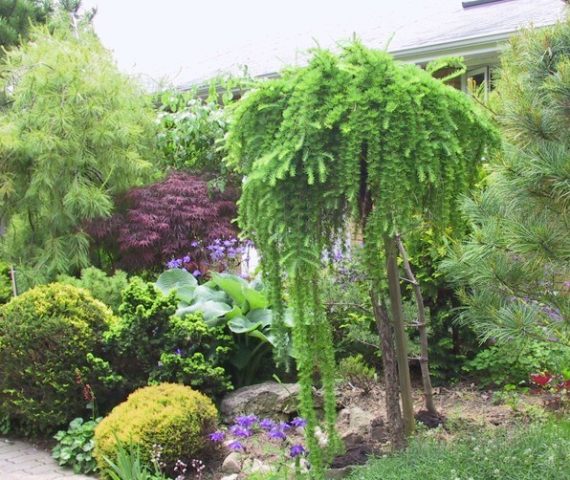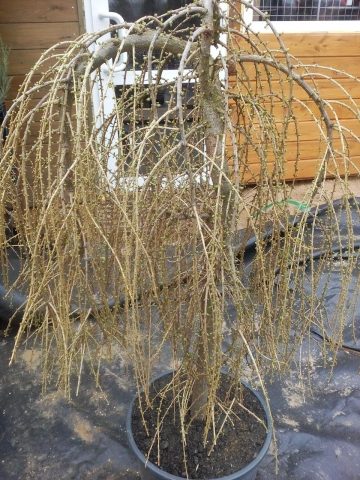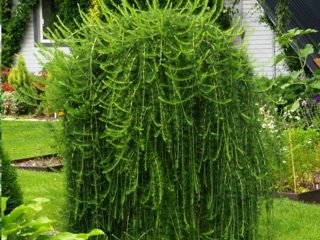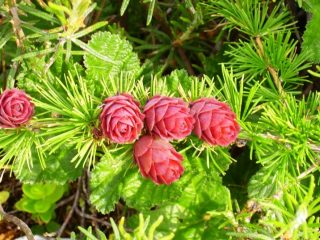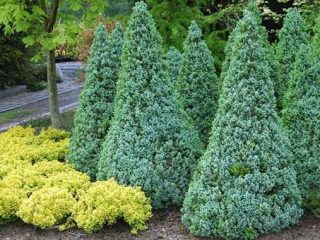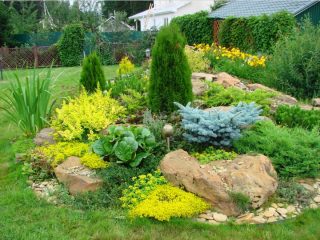Content
Pendula larch, or weeping larch, which is often sold grafted onto a trunk, creates an interesting accent in the garden with its shape, refreshing healing aroma and different colors according to the seasons. By winter, the low tree loses its needles, according to its appearance, but the original bends of the branches with the rudiments of shoots and cones are picturesque in their own way. Caring for frost-resistant larch is somewhat easier than caring for other conifers.
Description of European larch Pendula
The type of larch with drooping branches was systematized by botanists at the beginning of the 19th century and was found in the mountains of Europe. The tree grows up to 10-30 m. Unlike its mighty relatives, the decorative form Pendula, which is usually sold in nurseries, rises to 1.5-2 m. Sometimes, under favorable conditions, weeping larch grows up to 3 m, but usually not higher than the size of the trunk , onto which a cutting of the variety is grafted. Long, over 1-1.5 m, branches and the central conductor bend downwards. The side shoots of weeping larches are short. The diameter of the dense crown of the Pendula variety is 1 m.
Young branches have grayish bark; in adult larches the cover becomes dark brown. The root system is located deep, reliably protected from low temperatures and freezing of the upper soil layer.
The needle-shaped needles of the Pendula form are short - 3-3.5 cm, soft, grow in bunches. Color changes with the seasons:
- young, just growing in spring – light green;
- in summer it is bluish-green with a gray tint;
- from September - bright, golden yellow.
With cold weather, larch needles fall off. Ovoid cones up to 2-3 cm in size, green-yellowish and reddish-brown. Appear on mature trees after 8-10 years of development.
The larch species is winter-hardy and suitable for growing in the middle climate zone. For good development of the Pendula form, you need a sunny area or with light partial shade. The tree prefers moderately moist, slightly acidic or alkaline soil. The decorative form is planted in well-drained areas, avoiding low-lying areas. It tolerates drought relatively easily in adulthood, when a powerful root system has developed. In the first years of growth, weeping larch must be provided with regular watering. The Pendula variety is highly resistant to polluted city air and is little susceptible to pests and diseases, so the picturesque low-growing tree is a real boon for landscaping.
Pendula larch in landscape design
The weeping form is popular in garden design in small areas. Herbaceous plants develop well at the foot of the Pendula variety, since its crown allows sunlight to pass through and does not take up much space in width.Low-growing larch is combined with junipers, spruces, lindens, ash trees, oaks, and rhododendrons, provided they are planted in a sunny part of the garden. Low partners - ferns, sedums, astilbes.
The Pendula shape is used in different design options:
- larch looks beautiful when planted alone on a lawn or in a flower bed with low-growing flowers;
- effective in rocky and Japanese gardens;
- near the gazebos and in the entrance area;
- found grown in the form of an arch and for framing resting places using special pruning and shaping;
- element of hedges.
Planting and caring for Pendula larch
It is recommended to plant the Pendula form in the spring, when the tree is guaranteed to take root during the warm season.
Preparing seedlings and planting area
This type of coniferous tree does not like acidic soils, and therefore in such areas the substrate for the planting pit is specially prepared. Middle zone loams are good soil for larch. Humus and 200-300 g of dolomite flour are added to the garden soil. The depth of the pit is 80-90 cm, diameter is 60-70 cm. Drainage is also necessary. Before planting, the container with larch is watered abundantly. The seedling is carefully removed from the container, keeping the earthen lump, when the pit is ready for transshipment. The roots that are tangled in the container are carefully straightened, and if necessary, the ends are cut off with a sharp, disinfected knife.
Landing rules
It is necessary to preserve the earthen ball from the container, because larch, like other conifers, lives in symbiosis with mycorrhizal fungi.
Landing algorithm:
- 10-20 liters of water are poured onto part of the substrate in the pit;
- then the seedling is placed together with the support, which usually comes in a container, or replaced with a stronger one;
- the root collar remains above the ground;
- fill up the rest of the soil and compact it;
- A 5 cm layer of mulch made of peat, sawdust, and crushed bark is placed on top.
Watering and fertilizing
The Pendula seedling is watered regularly, making sure that the circle around the trunk does not dry out. In the evening, the plant benefits from sprinkling. In the first year, larch does not need to be fed, taking into account the amount of fertilizer in the container, as well as humus during planting. Next, the weeping form is maintained with special phosphorus-potassium fertilizers:
- "Kemira";
- "Pokon"
- Greenworld;
- "Osmocote".
Mulching and loosening
With the advent weed The mulch is removed and the soil is loosened, burning off all the blades of grass. You should not allow turf to appear under the young weeping form at first. Then mulch again. By autumn, the layer of mulch is doubled.
Trimming
In the spring, all annual shoots are pruned, each of which will then send out new branches, and the crown will become thicker. Gardeners themselves regulate the length of the falling branches. If they are not allowed to reach the soil itself, carry out regular pruning in the spring. The formation of the crown is also carried out. To obtain the tiered form of Pendula, the uppermost branches are tied to a high vertical support for several years. Then the regrown shoots are trimmed next spring, creating a new lush layer of crown.
Preparing for winter
At the end of September, in October, the larch is given moisture-recharging watering, 30-60 liters, and the tree trunk circle is mulched. During the first 4-5 years, the seedlings are covered with burlap and agrotextiles.It is also necessary to monitor the condition of the support so that it can withstand winter weather.
Pendula larch on a trunk
For small garden plots, it is better to buy only the grafted form of Pendula on a trunk, a low-growing tree up to 1.5-3 m tall. Tall natural larches rise to 8-10 m by the age of 15. Standard trees are universal for design and can be combined with many other plants.
Reproduction
The Pendula variety is propagated by seeds, which are collected from cones:
- First, the seeds are kept in water for a day;
- then mixed with sand in a wooden box and placed in the refrigerator for stratification for 30 days;
- seeds are sown on a mixture of peat and compost to a depth of 2 cm;
- sowing is covered with film;
- after germination, the film is removed, mulched with old sawdust or crushed bark, moderately moistened, but so that the soil does not dry out;
- transplantation is carried out after 1-2 years of development.
Rooting larch cuttings is problematic and is only possible for specialists using growth stimulants and film mini-greenhouses. The spread of Pendula larches usually occurs through grafting cuttings onto trunks, which is also done by professionals from nurseries.
Pests and diseases of Pendula larch
During the rainy and cold spring and summer months, Pendula needles may become infected with Schutte. During dangerous periods, wood is treated with the following preparations against fungi and pathogens:
- Bordeaux mixture;
- copper oxychloride;
- fungicide "Zineb" or others.
Aphids of coniferous plants (hermes) spoil the needles, which turn yellow.In addition to them, larch suffers from spider budworms, sawflies, and various bark beetles. Used against pests:
- "Decis";
- "Fozalon";
- "Rogor."
Conclusion
Pendula larch is an unpretentious, fast-growing and durable tree. Luxurious garden decoration enriches the air with pine aroma and healing phytoncides. The breed is quite resistant to diseases and pests, but spring prevention will ensure trouble-free development of the tree.
